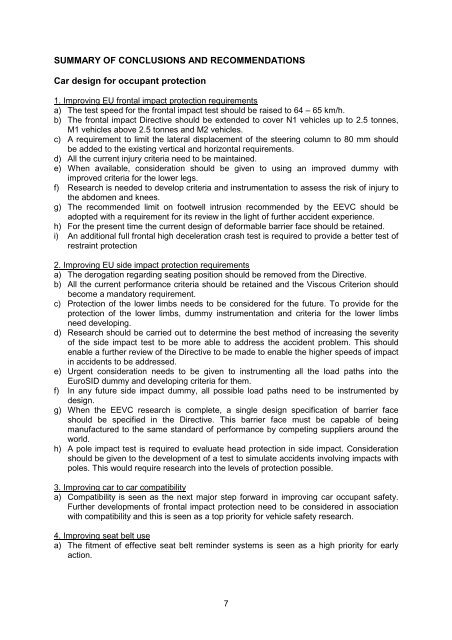PRIORITIES FOR EU MOTOR VEHICLE SAFETY DESIGN
priorities for eu motor vehicle safety design - ETSC
priorities for eu motor vehicle safety design - ETSC
You also want an ePaper? Increase the reach of your titles
YUMPU automatically turns print PDFs into web optimized ePapers that Google loves.
SUMMARY OF CONCLUSIONS AND RECOMMENDATIONS<br />
Car design for occupant protection<br />
1. Improving <strong>EU</strong> frontal impact protection requirements<br />
a) The test speed for the frontal impact test should be raised to 64 – 65 km/h.<br />
b) The frontal impact Directive should be extended to cover N1 vehicles up to 2.5 tonnes,<br />
M1 vehicles above 2.5 tonnes and M2 vehicles.<br />
c) A requirement to limit the lateral displacement of the steering column to 80 mm should<br />
be added to the existing vertical and horizontal requirements.<br />
d) All the current injury criteria need to be maintained.<br />
e) When available, consideration should be given to using an improved dummy with<br />
improved criteria for the lower legs.<br />
f) Research is needed to develop criteria and instrumentation to assess the risk of injury to<br />
the abdomen and knees.<br />
g) The recommended limit on footwell intrusion recommended by the EEVC should be<br />
adopted with a requirement for its review in the light of further accident experience.<br />
h) For the present time the current design of deformable barrier face should be retained.<br />
i) An additional full frontal high deceleration crash test is required to provide a better test of<br />
restraint protection<br />
2. Improving <strong>EU</strong> side impact protection requirements<br />
a) The derogation regarding seating position should be removed from the Directive.<br />
b) All the current performance criteria should be retained and the Viscous Criterion should<br />
become a mandatory requirement.<br />
c) Protection of the lower limbs needs to be considered for the future. To provide for the<br />
protection of the lower limbs, dummy instrumentation and criteria for the lower limbs<br />
need developing.<br />
d) Research should be carried out to determine the best method of increasing the severity<br />
of the side impact test to be more able to address the accident problem. This should<br />
enable a further review of the Directive to be made to enable the higher speeds of impact<br />
in accidents to be addressed.<br />
e) Urgent consideration needs to be given to instrumenting all the load paths into the<br />
EuroSID dummy and developing criteria for them.<br />
f) In any future side impact dummy, all possible load paths need to be instrumented by<br />
design.<br />
g) When the EEVC research is complete, a single design specification of barrier face<br />
should be specified in the Directive. This barrier face must be capable of being<br />
manufactured to the same standard of performance by competing suppliers around the<br />
world.<br />
h) A pole impact test is required to evaluate head protection in side impact. Consideration<br />
should be given to the development of a test to simulate accidents involving impacts with<br />
poles. This would require research into the levels of protection possible.<br />
3. Improving car to car compatibility<br />
a) Compatibility is seen as the next major step forward in improving car occupant safety.<br />
Further developments of frontal impact protection need to be considered in association<br />
with compatibility and this is seen as a top priority for vehicle safety research.<br />
4. Improving seat belt use<br />
a) The fitment of effective seat belt reminder systems is seen as a high priority for early<br />
action.<br />
7



